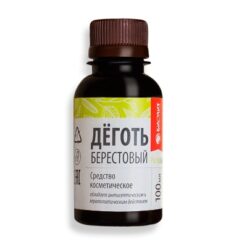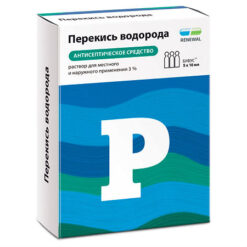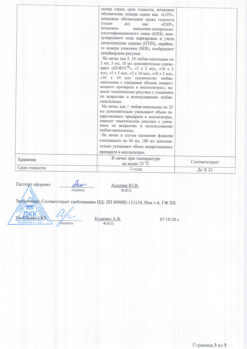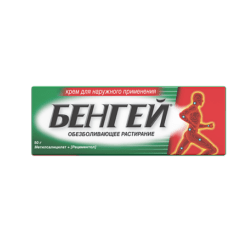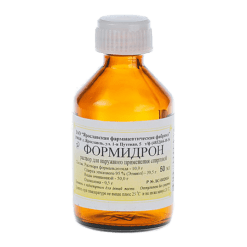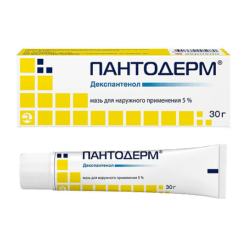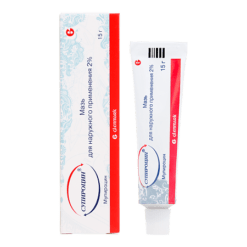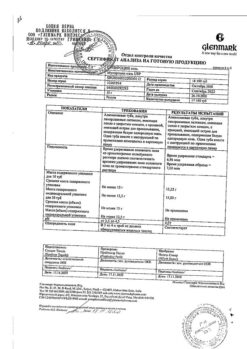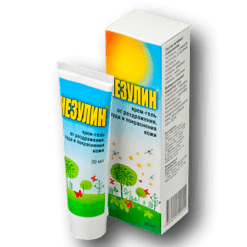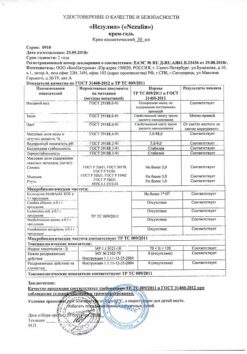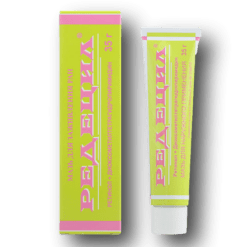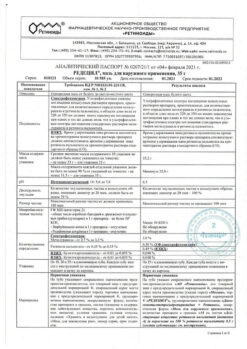No products in the cart.
Rheumonne, 10% spray, 50 ml
€1.00
Out of stock
(E-mail when Stock is available)
Description
NSAIDs for external use.
It has a local anti-inflammatory and analgesic effect.
Indications
Indications
– Injuries to soft tissues and joints
– Osteoarthritis, periarthritis of the shoulder joint, epicondylitis, lumbago
– Tendinitis, tenosynovitis, peritendinitis.
The drug is intended to reduce pain and inflammation at the time of use; it does not affect the progression of the disease.
Pharmacological effect
Pharmacological effect
Pharmacotherapeutic group
Nonsteroidal anti-inflammatory drug (NSAID)
ATX code: M02AA06
Pharmacological properties
Pharmacodynamics
Etofenamate is a non-steroidal anti-inflammatory drug with pronounced anti-inflammatory and analgesic properties.
Etofenamate acts at various points in the inflammatory process: in addition to inhibiting prostaglandin synthesis, inhibition of histamine release, an antagonistic effect on bradykinin and serotonin, inhibition of complement activity and inhibition of hyaluronidase release were detected. The membrane-stabilizing properties of the drug prevent the release of proteolytic enzymes, resulting in inhibition of exudative-proliferative processes of inflammation, as well as a decrease in anaphylactic reactions and reactions to foreign bodies.
Etofenamate has a lipophilic nature, which determines its good penetration through the skin.
Pharmacokinetics
Suction
Etofenamate penetrates the skin and is distributed into the affected tissue, where it reaches therapeutic concentrations. Maximum plasma concentrations are achieved after a single application of 300 mg etofenamate 12 to 24 hours after application.
Distribution
The distribution of etofenamate is characterized by accumulation in inflamed tissue, where the implementation of the therapeutic effect is necessary. Etofenamate is highly bound to plasma proteins (about 99%). The binding of the active metabolite of the drug, flufenamic acid, to plasma proteins is >99%. The relative bioavailability of the drug is 20%.
Metabolism
Etofenamate is metabolized in the liver by oxidation and conjugation. The substance decomposes to 5-OH-, 4′-OH-, and 5,4′-dihydroxyethofenamate and flufenamic acid (active metabolites), as well as 5-OH, 4′-OH, and 5,4′-dihydroxyflufenamic acid.
Removal
Etofenamate is excreted in the form of various metabolites and their conjugates through the kidneys (55%) or with feces. The half-life after topical application is 3.3 hours.
Special instructions
Special instructions
Do not apply to inflamed or damaged skin (including open wounds). Avoid contact with eyes. It is recommended to wash your hands thoroughly after using the drug. Do not use under an occlusive dressing.
The risk of systemic adverse reactions increases depending on the amount of the drug applied, the area of the treated skin area, and the duration of therapy. Avoid exposure of treated areas to sunlight or UV rays, including solariums, during therapy and for 2 weeks after therapy. Avoid contact with parts of the body to which the drug has been applied.
Do not allow children to touch skin on which the drug has been applied.
Impact on the ability to drive vehicles and machinery
The use of the drug Revmonn spray for external use does not affect the ability to perform potentially hazardous activities that require increased concentration of attention and speed of psychomotor reactions (driving vehicles, working with moving mechanisms, working as a dispatcher, operator).
Active ingredient
Active ingredient
Etofenamate
Composition
Composition
Composition per 1 ml:
Active ingredient:
Etofenamate 100.0 mg
Excipients:
Diisopropyl adipate 100.0 mg; cetomacrogol oleate 60.0 mg; macrogol-400 30.0 mg; iso-propanol 385.0 mg; propylene glycol 40.0 mg; purified water 222.5 mg.
Pregnancy
Pregnancy
Revmonn spray for external use is contraindicated for use during pregnancy, as it has been established that etofenamate crosses the placental barrier.
During the period of use of the drug Revmonn spray for external use, nursing mothers should stop breastfeeding.
Contraindications
Contraindications
Hypersensitivity to etofenamate or excipients, flufenamic acid and other non-steroidal anti-inflammatory drugs. Complete or incomplete combination of bronchial asthma, recurrent polyposis of the nose and paranasal sinuses and intolerance to acetylsalicylic acid or other NSAIDs (including a history). Violation of the integrity of the skin at the intended site of application. Exposure of the treated areas to sunlight, including ultraviolet rays from a solarium during the course of using the drug and for 2 weeks after use. Pregnancy. Breastfeeding period. Children under 18 years of age.
With caution
Erosive and ulcerative lesions of the gastrointestinal tract, severe dysfunction of the liver and kidneys, chronic heart failure, old age, inflammatory or infectious skin diseases.
In patients with bronchial asthma, chronic obstructive pulmonary disease, hay fever or chronic swelling of the nasal mucosa (so-called nasal polyps) or chronic infectious diseases of the respiratory tract, especially in combination with hay fever-like manifestations, etofenamate in all dosage forms can only be used under medical supervision.
Side Effects
Side Effects
The frequency of adverse reactions is determined as follows:
Very common (≥1/10)
Often (≥1/100 to <1/10)Uncommon (≥1/1,000 to <1/100)Rare (≥1/10,000 to <1/1,000)Very rare (< 1/10,000)Frequency unknown (cannot be estimated from available data)Disorders of the skin and subcutaneous tissueUncommon: erythema, burning sensation of the skin
Very rare: dermatitis (i.e. intense itching, rash, erythema, swelling, bullous rash).
Frequency unknown: photosensitivity
Immune system disorders
Frequency unknown: hypersensitivity.
There have been reports of hypersensitivity reactions following the use of NSAIDs. They could include nonspecific allergic reactions and anaphylaxis, airway reactivity including bronchial asthma, severe asthma, bronchospasm or dyspnea, or various skin disorders including various types of rashes, pruritus, urticaria, purpura, angioedema or, more rarely, exfoliative or bullous dermatosis (including epidermal necrolysis or erythema multiforme). If any of these symptoms appear, which is possible even after the first application, you should stop using the drug and seek immediate medical attention.
Interaction
Interaction
The interaction of Revmonn spray for external use with other drugs has not been established.
Overdose
Overdose
There is no information on cases of overdose of Revmonn spray for external use.
In case of accidental ingestion, systemic adverse reactions may develop. Treatment: gastric lavage, induction of vomiting, activated charcoal, forced diuresis, symptomatic therapy; dialysis is not effective due to the high degree of protein binding of etofenamate (about 99%).
When applying a large amount of the drug to a large area of the skin for a short time, headache, dizziness and epigastric discomfort may occur. Treatment: it is necessary to wash off the drug with water.
Storage conditions
Storage conditions
At a temperature not exceeding 25 °C.
Keep out of the reach of children.
Shelf life
Shelf life
3 years.
Do not use after the expiration date indicated on the package.
Manufacturer
Manufacturer
Switzerland
Additional information
| Shelf life | 3 years. |
|---|---|
| Conditions of storage | Store in a dry place protected from light. |
| Manufacturer | Switzerland |
| Medication form | topical spray |
Related products
Buy Rheumonne, 10% spray, 50 ml with delivery to USA, UK, Europe and over 120 other countries.


